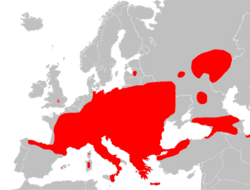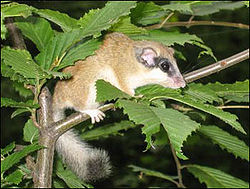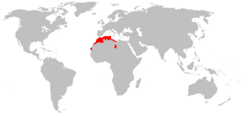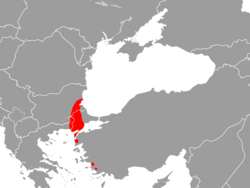| Common name | Scientific name and subspecies | Range | Size and ecology | IUCN status and estimated population |
|---|
| Angolan African dormouse
| G. angolensis
De Winton, 1897 | Angola and Zambia
 | Size: 7–12 cm (3–5 in) long, plus 7–10 cm (3–4 in) tail [8]
Habitat: Forest [9] | DD
Unknown  [9] [9]
|
|---|
| Christy's dormouse
| G. christyi
Dollman, 1914 | Central Africa
 | Size: 8–11 cm (3–4 in) long, plus 7–10 cm (3–4 in) tail [8]
Habitat: Forest [10] | LC
Unknown  [10] [10]
|
|---|
| Jentink's dormouse
| G. crassicaudatus
(Jentink, 1888) | Western Africa
 | Size: 8–10 cm (3–4 in) long, plus 5–7 cm (2–3 in) tail [8]
Habitat: Forest [11] | DD
Unknown  [11] [11]
|
|---|
| Johnston's African dormouse
| G. johnstoni
Thomas, 1898 | Malawi
 | Size: 6–9 cm (2–4 in) long, plus 6–8 cm (2–3 in) tail [8]
Habitat: Savanna [12] | DD
Unknown  [12] [12]
|
|---|
| Kellen's dormouse  | G. kelleni
(Reuvens, 1890) | Scattered Sub-Saharan Africa
 | Size: 7–10 cm (3–4 in) long, plus 5–9 cm (2–4 in) tail [8]
Habitat: Savanna and forest [13] | LC
Unknown  [13] [13]
|
|---|
| Lorrain dormouse
| G. lorraineus
Dollman, 1910 | Western and central Africa
 | Size: 7–10 cm (3–4 in) long, plus 5–8 cm (2–3 in) tail [8]
Habitat: Savanna and forest [14] | LC
Unknown  [14] [14]
|
|---|
| Monard's dormouse
| G. monardi
(St. Leger, 1936) | South-central Africa
 | Size: About 16 cm (6 in) long, plus about 13 cm (5 in) tail [8]
Habitat: Savanna [15] | DD
Unknown  [15] [15]
|
|---|
| Nagtglas's African dormouse
| G. nagtglasii
Jentink, 1888 | Western Africa
 | Size: 12–16 cm (5–6 in) long, plus 6–13 cm (2–5 in) tail [8]
Habitat: Forest [16] | LC
Unknown  [16] [16]
|
|---|
| Rock dormouse
| G. platyops
Thomas, 1897 | Southern Africa
 | Size: 9–13 cm (4–5 in) long, plus 6–10 cm (2–4 in) tail [8]
Habitat: Forest and rocky areas [17] | LC
Unknown  [17] [17]
|
|---|
| Silent dormouse
| G. surdus
Dollman, 1912 | Western Africa
 | Size: 8–11 cm (3–4 in) long, plus 6–9 cm (2–4 in) tail [8]
Habitat: Forest [18] | DD
Unknown  [18] [18]
|
|---|
| Small-eared dormouse  | G. microtis
(Noack, 1887) | Scattered Sub-Saharan Africa
 | Size: 7–12 cm (3–5 in) long, plus 6–9 cm (2–4 in) tail [8]
Habitat: Forest, savanna, and shrubland [19] | LC
Unknown  [19] [19]
|
|---|
| Spectacled dormouse  | G. ocularis
(Smith, 1829) | South Africa
 | Size: 11–15 cm (4–6 in) long, plus 10–15 cm (4–6 in) tail [8]
Habitat: Shrubland and rocky areas [20] | LC
Unknown  [20] [20]
|
|---|
| Stone dormouse
| G. rupicola
(Thomas & Hinton, 1925) | Namibia and South Africa
 | Size: 10–12 cm (4–5 in) long, plus 9–12 cm (4–5 in) tail [8]
Habitat: Rocky areas [21] | LC
Unknown  [21] [21]
|
|---|
| Walter Verheyen's African dormouse
| G. walterverheyeni
Holden & Levine, 2009 | Democratic Republic of the Congo
 | Size: About 7 cm (3 in) long, plus about 6 cm (2 in) tail [8]
Habitat: Forest [22] | DD
Unknown  [22] [22]
|
|---|
| Woodland dormouse 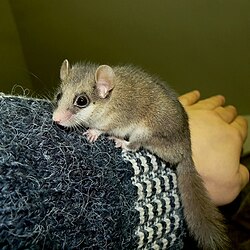 | G. murinus
(Desmarest, 1822) | Eastern and southern Africa
 | Size: 8–12 cm (3–5 in) long, plus 7–9 cm (3–4 in) tail [8]
Habitat: Inland wetlands, grassland, shrubland, savanna, and forest [23] | LC
Unknown  [23] [23]
|
|---|



